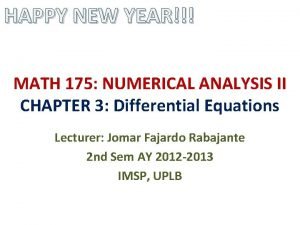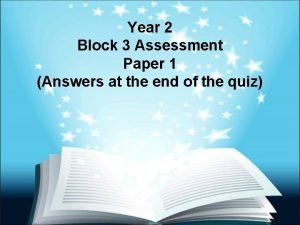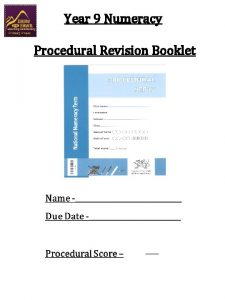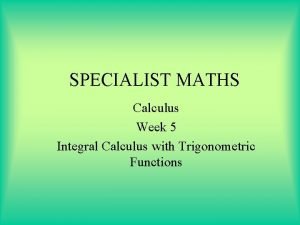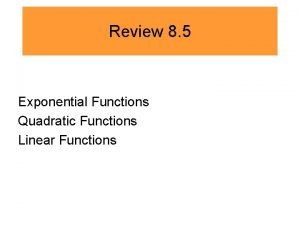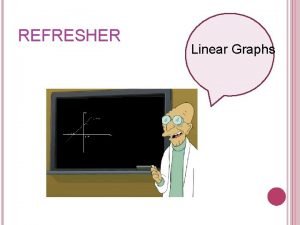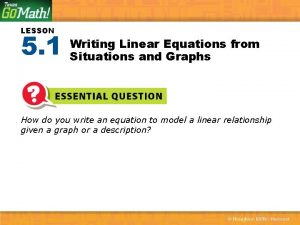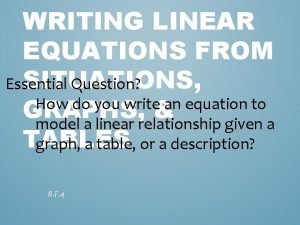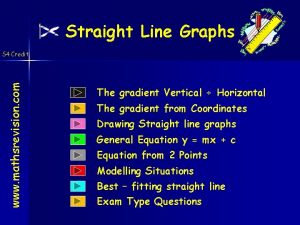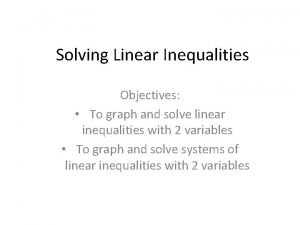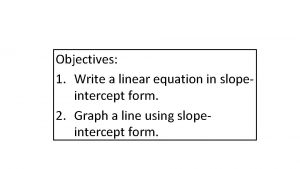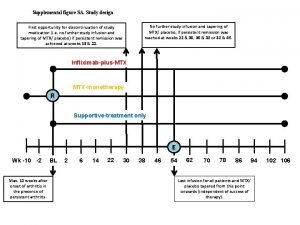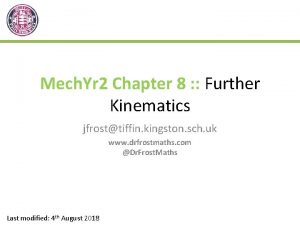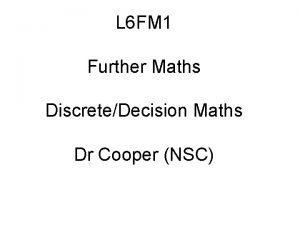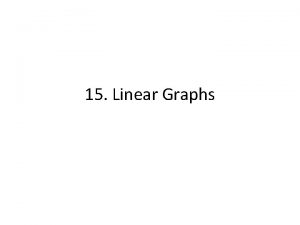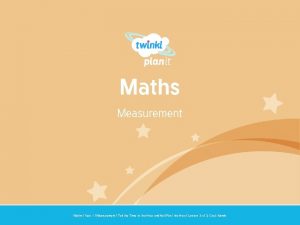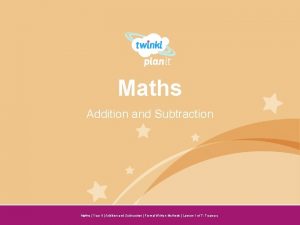LINEAR GRAPHS Year 10 Maths for Further LINEAR

























































- Slides: 57

LINEAR GRAPHS Year 10 Maths for Further

LINEAR GRAPHS Plotting using a table of values • Given a linear equation, we can use values for x, substitute these into the equation and solve for y. • This gives us sets of coordinates which we can plot on an axis. • When we join these dots together, they form the graph of our linear equation. Lets see what this looks like…. .

Co-ordinates (x, y) -3 -1 1 3 5

5 -3 -1 1 3 5 4 3 2 1 -2 -1 0 -1 -2 -3 1 2 3 4

WORKSHEET ONE DO NOW

LINEAR GRAPHS Finding the gradient when we are given the graph • The gradient of a graph refers to the slope / steepness of the graph

LINEAR GRAPHS

LINEAR GRAPHS

LINEAR GRAPHS

LINEAR GRAPHS

WORKSHEET TWO DO NOW

FINDING THE EQUATION OF A LINE Exercise 1 E / 1 F Key Terms • The gradient of a graph, m, refers to the steepness / slope of the line • The intercepts are points where the line crosses the x-axis and y -axis: The y-intercept is the point that the line crosses the y-axis. At this point x = 0. The x-intercept is the point that the line crosses the x-axis. At this point y = 0.

FINDING THE EQUATION OF A LINE y-intercept gradient

FINDING THE EQUATION OF A LINE gradienty-intercept eg 1. The graph pictured, has a gradient of 1. Find the equation of the graph. 1 3

FINDING THE EQUATION OF A LINE gradienty-intercept 2

FINDING THE EQUATION OF A LINE gradienty-intercept gradient = m= 6 eg 3. For the graph pictured, find the gradient, the y-intercept and then state the equation of the graph.

FINDING THE EQUATION OF A LINE gradienty-intercept eg 4. For the graph pictured, find the gradient, the y-intercept and then state the equation of the graph. gradient = m= 3

FINDING THE EQUATION OF A LINE gradienty-intercept gradient = m= y-intercept eg 5. For the graph pictured, find the gradient, the y-intercept and then state the equation of the graph. 0 2

FINDING THE EQUATION OF A LINE gradienty-intercept eg 6. For the graph pictured, find the gradient, the y-intercept and then state the equation of the graph. gradient = undefined m= no y-intercept

Ex 1 E Ex 1 F pg 31 Q 3 pg 37 Q 2 bcf, Q 3 bcfil, Q 4 bcf. NOW DO

GRAPHING STRAIGHT LINES

GRAPHING STRAIGHT LINES Using the gradient-intercept method Now lets try graphing them. a) gradient y-intercept

GRAPHING STRAIGHT LINES Using the gradient-intercept method b) gradient y-intercept

GRAPHING STRAIGHT LINES Using the gradient-intercept method c) gradient y-intercept

Ex 1 E pg 31 Q 1, Q 5 cdhl, Q 6 cdh, Q 8 cdhl NOW Ex 1 F pg 37 Q 2 bcf, Q 3 bcfil, Q 4 bcf. DO

GRAPHING STRAIGHT LINES (0, (-1. 5, 0)

GRAPHING STRAIGHT LINES Using the x and y intercepts eg. 2 y - 4 x = 6 (0, 3) (-1. 5, 0)

GRAPHING STRAIGHT LINES Using the x and y intercepts eg 2. 3 y – 2 x = 12 (0, 4) (-6, 0)

GRAPHING STRAIGHT LINES Using the x and y intercepts eg 3. y + 3 x = 9 ( 0, 9 ) ( 3, 0 )

GRAPHING STRAIGHT LINES Using the x and y intercepts eg 4. y = 4 x + 8 ( 0, 8 ) ( -2, 0 )

Using the x and y intercept method for these problems Ex 1 E pg 31 Q 6 abde NOW DO

FINDING IF A POINT IS ON A LINE If we are given a linear equation and a point (set of co-ordinates), we can find if that point is on the graph of the equation. Look at the following example… eg. For the equation (1, 4) y = 4 x + 6, is the point ( 1, 4) on it’s line? Step 1: Substitute the x value given in the point in question, in this case x = 1 into the equation. Step 2: Solve the equation. (IF the y value is equal to the y value given in the question, in this case y = 4 then the point IS on the line) Once solved, this examples gives us y = 10 so the point is NOT on the line the equation y = 4 x + 6

FINDING IF A POINT IS ON A LINE eg 2. For the equation y = -2 x + 3, is the point ( 4, -5) on it’s line? Proof: Step 1: Substitute the x value given in the point in question, in this case x = 4 into the equation. Step 2: Solve the equation. If the y value is equal to the y value given in the question, in this case y = -5 then the point IS on the line. Once solved, this examples gives us y = -5 so the point (4, -5) IS on the line the equation y = -2 x + 3

Ex 1 E pg 31 Q 4 bcf NOW DO

SIMULTANEOUS EQUATIONS When we try to find a solution to a set of two equations rather than just a single equation, we say that we are solving simultaneous equations. That is, we are finding the point where both equations share the same solution. We can solve simultaneous equations in a number of ways. We are going to be solving these in 3 ways: • For a given point (set of co-ordinates), find if the point is on the line for each equation. • Graphing two equations and finding the point where they intersect. • Using the substitution method - taking one equation and substituting in into the other and solving for x and y.

SIMULTANEOUS EQUATIONS For a given point (set of co-ordinates), find if the point is on the line for each equation. So ( 2, 1 ) is the eg 1. Is the point ( 2, 1 ) a solution to the linear equations: solution to the equations y = x - 1 y=x– 1 2 y + 3 x = 8 and 2 y + 3 x = 8 Sub in x = 2 Solve Subtract 6 from both sides Divide both sides by 2 This satisfies the co-ordinates of (2, 1) so this IS a solution of our y=x– 1 This satisfies the co-ordinates of (2, 1) so this IS a solution of our 2 y +

SIMULTANEOUS EQUATIONS For a given point, find if the point is on the line for each equation. eg 2. Is the point ( 1, 5 ) a solution to the linear equations: 3 y – 4 x = 2 6 x + 2 y = 4 Sub in x = 1 Add 4 to both sides Divide both sides by 3 This does NOT satisfy the coordinates of (1, 5) so this IS NOT a solution of 3 y - 4 x = 2 Now try for our other equation…… Sub in x = 1 Subtract 6 from both sides Divide both sides by 2 This does not NOT satisfy the co-ordinates of (1, 5) so this IS NOT a solution of our 6 x + 2 y So=( 41, 5 ) is NOT the solution of the simultaneous equations 3 y – 4 x = 2 and 6 x

SIMULTANEOUS EQUATIONS For a given point, find if the point is on the line for each equation. eg 3. Is the point ( 3, 6 ) a solution to the linear equations: y = 3 x - 3 y = 4 x – 2 Sub in x = 3 Solve This satisfies the co-ordinates of This does not satisfy the co(3, 6) so this IS a solution of our ordinates of (3, 6) so this IS NOT y = 3 x – 3 a solution of our y = 4 x – 2 Now try for our other So ( 3, 6 ) is NOT the solution of the equation…… simultaneous equations y = 3 x - 3 and y =

SIMULTANEOUS EQUATIONS For a given point, find if the point is on the line for each equation. eg 2. Is the point ( 3, 6 ) a solution to the linear equations: y = 3 x - 3 y = 4 x – 2 eg 3. Is the point ( 1, 5 ) a solution to the linear equations: 3 y – 4 x = 2 7 x + 2 y = 4

Ex 1 I pg 53 Q 1 aceg NOW DO

SIMULTANEOUS EQUATIONS Graphing two equations and finding the point where they intersect. If we want to find the unique solution to two linear graphs, we can graph them both on the same plot and find the point where they intersect. The co-ordinates at this point is the solution to the simultaneous equations. eg. For the equations: y = -x + 4 y = 2 x – 5 The two lines intersect at ( 3, 1 ), so the solution is ( 3, 1 ) which is, x = 3, y = 1

SIMULTANEOUS EQUATIONS Graphing two equations and finding the point where they intersect. y = -x eg 1. Find the point of intersection of the+ 1 following pair of equations. y = 3 x - 3 y = -x + 1 Step 1: Plot the graphs together on one plot. Step 2: Highlight the point of intersection. The pair of equations intersect at ( 1, 0 ) so the solution to the simultaneous equations is ( 1, 0 ) – or we can say x = 1, y = 0. y = 3 x 3

SIMULTANEOUS EQUATIONS Graphing two equations and finding the point where they intersect. y = 2 x eg 2. Find the point of intersection of the +1 following pair of equations. y=3 y = 2 x + 1 Step 1: Plot the graphs together on one plot. Step 2: Highlight the point of intersection. The pair of equations intersect at ( 1, 3 ) so y= 3

SIMULTANEOUS EQUATIONS Graphing two equations and finding the point where they intersect. eg 2. (cont’d) From our last example, I will now show you how to plot these on your calculator. y=3 y = 2 x + 1 * Choose MENU GRAPHS & TABS enter the equations into y 1 and y 2 and tick the check boxes beside each equation * Press the graph icon

SIMULTANEOUS EQUATIONS Graphing two equations and finding the point where they intersect. eg 2. (cont’d) From our last example, I will now show you how to plot these on your calculator. y=3 y = 2 x + 1 Find the point of intersection using: ANALYSIS G-Solve Intersect Point of Intersection (1, 3)

Ex 1 I pg 53 Q 2 abcde NOW DO

SIMULTANEOUS EQUATIONS: WORDED PROBLEMS Gradient = 500 y-intercept = 1000 Gradient = 250 y-intercept = 2000

If hiring the venue for less than 4 hours, Schweppes Centre is cheapest. If hiring the venue for more than 4 hours, the Capital is cheapest. If hiring for exactly 4 hours, costs are equal.

Finish off worksheet NOW DO

WORDED PROBLEMS b) So…. A pen costs 50 cents An exercise book

SIMULTANEOUS EQUATIONS Using the SUBSTITUTION method Another way to solve simultaneous equations is by using substitution. We take one equation and substitute it in into the other and solve for x and y. What does this look like? eg. Solve the following simultaneous equations: 5 y=x+2 2 x + y = Step One: Substitute ‘ y = x + 2 ’ into the ‘ y ’ of the other equation. Step Two: Solve for x. Step Three: Substitute your solution to x into ‘ y = x + 2’ to solve for y The solution to the simultaneous

SIMULTANEOUS EQUATIONS Using the SUBSTITUTION method eg 2. Solve the following simultaneous equations: 2 y = 16 y = 2 x + 1 3 x + Step One: Substitute ‘ y = 2 x + 1 ’ into the ‘ y ’ of the other equation. Step Two: Solve for x. Step Three: Substitute your solution to x into ‘ y = 2 x + 1’ to solve for y equations is The solution to the simultaneous

SIMULTANEOUS EQUATIONS Using the SUBSTITUTION method eg 3. Solve the following simultaneous equations: -1 y = 3 x + 2 y = 6 x Step One: Substitute ‘ y = 3 x + 2 ’ into the ‘ y ’ of the other equation. Step Two: Solve for x. Step Three: Substitute your solution to x into either equation to solve for y equations is The solution to the simultaneous ( 1, 5 )

SIMULTANEOUS EQUATIONS Using the SUBSTITUTION method

SIMULTANEOUS EQUATIONS Using the calculator to solve The calculator can also solve these problems for us.

SIMULTANEOUS EQUATIONS Using the calculator to solve The calculator can also solve these problems for us.

Ex 1 I pg 54 Q 4 bdfh White = show working Q 5 bdfhj NOW Red = use calculator DO
 Springs and strings
Springs and strings Time series further maths
Time series further maths Encoding bugs in software testing
Encoding bugs in software testing Graphs that compare distance and time are called
Graphs that compare distance and time are called Graphs that enlighten and graphs that deceive
Graphs that enlighten and graphs that deceive 5-3 polynomial functions
5-3 polynomial functions Straight line graphs dr frost
Straight line graphs dr frost Mr barton maths
Mr barton maths Interpreting line graphs year 5
Interpreting line graphs year 5 Mental maths year 5
Mental maths year 5 Mental maths questions year 5
Mental maths questions year 5 Wigan lea mental maths
Wigan lea mental maths Year 4 mental maths test
Year 4 mental maths test Year 3 mental maths test
Year 3 mental maths test Wigan mental maths year 1
Wigan mental maths year 1 Maths mastery year 3
Maths mastery year 3 Year 6 maths investigations
Year 6 maths investigations Ready set go maths
Ready set go maths Year 4 mental maths tests
Year 4 mental maths tests Year 2 mental maths test
Year 2 mental maths test Math equation happy new year
Math equation happy new year Answer sheet
Answer sheet Mental maths tests year 3
Mental maths tests year 3 Year 2 mental maths test
Year 2 mental maths test Year 2 mental maths test
Year 2 mental maths test Wigan lea mental maths year 6
Wigan lea mental maths year 6 Year 11 general maths
Year 11 general maths Wigan mental maths year 1
Wigan mental maths year 1 Year 9 maths revision booklet
Year 9 maths revision booklet Mental maths test year 5
Mental maths test year 5 Year 3 mental maths tests
Year 3 mental maths tests Year 3 mental maths test
Year 3 mental maths test Year 11 specialist formula sheet
Year 11 specialist formula sheet Year 5 mental maths test questions and answers
Year 5 mental maths test questions and answers Wigan mental maths year 5
Wigan mental maths year 5 Year 1 mental maths test
Year 1 mental maths test Poems for leavers assembly
Poems for leavers assembly How to tell if a graph is linear quadratic or exponential
How to tell if a graph is linear quadratic or exponential Interpreting linear graphs
Interpreting linear graphs Writing linear equations from situations and graphs
Writing linear equations from situations and graphs 5-1 writing linear equations from situations and graphs
5-1 writing linear equations from situations and graphs Linear vs quadratic vs exponential
Linear vs quadratic vs exponential Linear vs nonlinear equations
Linear vs nonlinear equations Linear graphs
Linear graphs Linear equation graphs worksheet
Linear equation graphs worksheet How to write a linear equation
How to write a linear equation Oscalar
Oscalar Difference between further and furthermore
Difference between further and furthermore Further study design
Further study design Naval terms and phraseologies
Naval terms and phraseologies Dr frost further kinematics
Dr frost further kinematics Not for further distribution
Not for further distribution This is to certify further
This is to certify further Further applications of integration
Further applications of integration Further applications of integration
Further applications of integration Havering college of further and higher education
Havering college of further and higher education Metaphor definition
Metaphor definition English for further studies
English for further studies




















